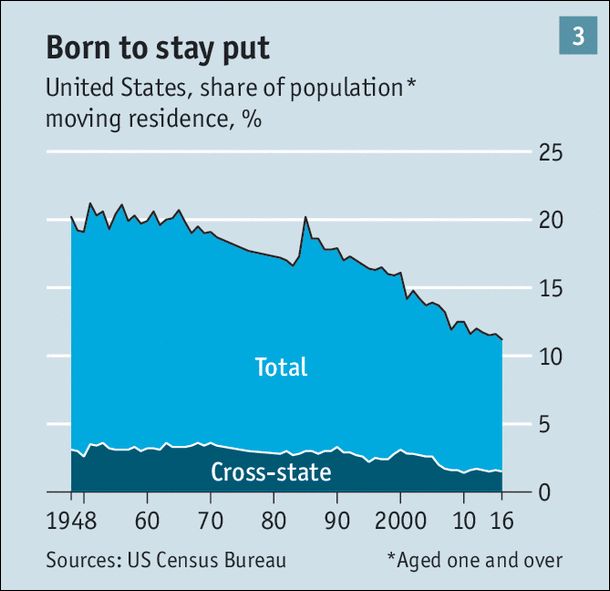The typical college student enrolls in a college 13 miles from home. A nationwide study on social connectedness found that 63% of the people we friend on Facebook live within 100 miles. The percentage of Americans that move across state lines each year has fallen by half since the 1990s. We are becoming less mobile.
Rooted in place.
Young people aged 25-34 seem especially stuck. Although job prospects have improved, many are still living in their parents’ homes or in apartments with multiple roommates. They are marrying later, having children later, and large student debts may be keeping them from buying a home (Pew Research Center, 2017). In larger urban centers favored by young adults, limited new building is making housing hard to afford. Just getting started has been tough.
NeXters face other headwinds besides the purse. They don’t just change jobs if they move; they also sever familiar social ties, from churches to sports bars (inertia trap*). Some find themselves needing to care for ailing parents. Others are relying on grandparents to provide a crucial source of child care. For those stuck in the wrong place, opportunities are limited.
Home is where the dough is.
In his book, The Big Sort, journalist Bill Bishop says Americans are increasingly clustering in distinct areas on the basis of their jobs and social values. For example, a recent study by the Brookings Institution of computer skills used in various occupations scored San Jose the highest, then Boston, then Austin, Hartford, and Salt Lake City. Bakersfield tied with Las Vegas for the lowest average score among large cities. Vibrant clusters benefit from talented, creative employees who gravitate to these places to work with like-minded people.
 Companies are moving back to older cities and these revitalized urban centers are becoming magnets for young professionals (see: They went that-a-way). In “Where are millennials moving to?” Apartment List Rentonomics looked at 345 metros and found that young adults are attracted by strong job markets. The top spots in population growth for Millennials from 2005-2015 (based on the 50 largest metro areas) are:
Companies are moving back to older cities and these revitalized urban centers are becoming magnets for young professionals (see: They went that-a-way). In “Where are millennials moving to?” Apartment List Rentonomics looked at 345 metros and found that young adults are attracted by strong job markets. The top spots in population growth for Millennials from 2005-2015 (based on the 50 largest metro areas) are:
- Charlotte (30.7%)
- Houston (17.4%)
- Austin (16.4%)
- Seattle (15.3%)
- Omaha (14.3%)
High-growth entrepreneurship has also rebounded. Got a big idea? Analysis by the Kauffman Foundation reveals that such “gazelles” are luring ambitious talent to some unexpected places. In these areas, local governments increasingly support soft infrastructure that greatly boost startups’ chances of success. Hot cities include San Francisco, Minneapolis-St. Paul, Provo, Austin, Columbus, Nashville, Washington D.C., and Charleston. Tulsa is aiming to attract people by offering those who work remotely and entrepreneurs $10,000 to move there.
The burbs are back.
Worried about the quality of schools and the safety of streets, older NeXters having children may be falling out of love with urban centers. According to the National Association of Realtors, suburbs’ population gains now outpace cities. Greater than half of Americans below the age of 37—the majority of home-buyers—are now settling in suburban places. And a Zillow Group survey of 13,000 renters and homeowners found that half of home buyers are under age 36. The bottom line: young persons are stealthily changing the real-estate landscape.
What’s in the tea leaves for aging Baby Boomers? More are heading for retirement in warm, low-density areas. Recent data indicates that western states including Idaho, Nevada, Utah, and Washington saw the fastest growth. Four states saw an overall decline in population, Illinois plus three states heavily dependent on declining energy industries—Wyoming, West Virginia and Alaska. As we warm up for shuffleboard, we thank you for your support!
Toto, I’ve a feeling we are not in Kansas anymore.
~ Dorothy, in The Wizard of Oz
* Questionable beliefs can “trap” our better judgment, leading to poor decisions and unintended consequences. In the inertia trap, we tend to be overly influenced by our peers. Learn more about this, and other interesting topics, in the Young Person’s Guide to Wisdom, Power, and Life Success.
Image credit: “Beautiful and smiling happy interracial young couple” by Pablo Hidalgo, licensed from 123rf.com (2018).






















